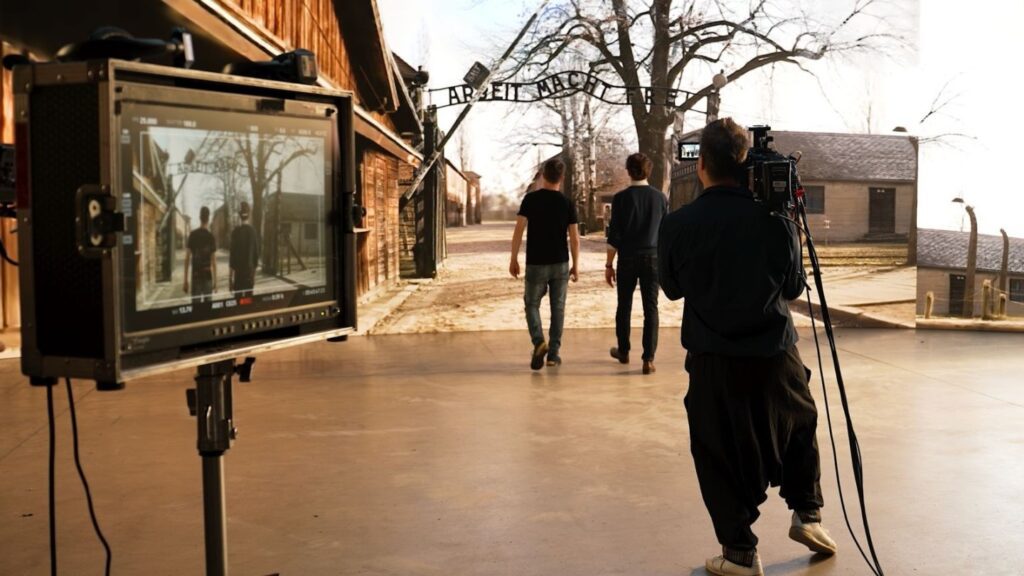Innovative Approaches to Filmmaking at Auschwitz-Birkenau
Restrictions on Filming at Auschwitz-Birkenau
Filmmakers have faced significant barriers when seeking permission to shoot at Auschwitz-Birkenau, one of the most notorious Nazi concentration and extermination camps. Steven Spielberg encountered this challenge while working on “Schindler’s List,” which resulted in his crew constructing a replica of the camp near Birkenau instead of filming on the actual site.
Digital Solutions for Historical Representation
As the 80th anniversary of the camp’s liberation approaches, access to Auschwitz has evolved. With a dwindling number of survivors and an increase in global visitation, innovative digital technologies are now being utilized to recreate the site’s history. Collaborations between the Auschwitz-Birkenau Museum, the Auschwitz-Birkenau Foundation, and the film industry are paving the way for accurate visual representations of this significant location.
New Filming Guidelines
According to Wojciech Soczewica, CEO of the Auschwitz-Birkenau Foundation, the site has been largely inaccessible for filmmaking for the past 40 years. However, smaller documentaries that pose minimal risk to the site’s integrity are now permitted to be filmed. Soczewica states, “The documentary can be filmed because it is not a large production. It does not pose a serious risk to real roads, buildings, stairs, or personal items of victims and survivors.”
Ethical and Accurate Storytelling
The integration of modern technology aims to facilitate filmmakers’ access to historical details while preserving the sanctity of the site. Experts led by Maciej Shamozin have employed cutting-edge 3D scanning technology to create certified digital replicas of Auschwitz. These digital tools are designed not only for accurate representation but also to counteract misinformation.
- Innovative tools for documentaries and large-scale Hollywood productions.
- Focus on ethical storytelling, providing historical context.
- Support for combating anti-Semitism and all forms of hatred through artistic expression.
Events and Collaborations
Prominent figures in film are engaging with these new initiatives. Agnieszka Holland, a notable Polish director, and Holocaust survivor Lissard Horowitz participated in discussions at the Cannes Film Festival about the importance of these projects. The collaboration aims to leverage technology responsibly while staying true to the historical narrative.
Preservation of Memory Through Technology
The digital replica project seeks to create a comprehensive 1:1 representation of Auschwitz I, with further plans for Auschwitz II-Birkenau. This meticulous documentation aims to preserve the memories associated with the camp, enabling future generations to connect with its history ethically.
“We really believe that it will be reprocessed in the future by 100 years or even nonexistent technology.” – Maciej Shamozin
Reflections from Survivors
Survivor Horowitz shares a profound sentiment, emphasizing the importance of preserving the site’s history for future generations. He reflects on his journey: “I have saved as many generations as possible for as many generations as possible… Revisionists can make more personal contact with the camp.”
Changing Perspectives in Storytelling
Filmmakers, such as the Dutch director mentioned in the original discussions, have expressed a desire to revisit narratives surrounding Auschwitz. With evolving societal contexts, there is a renewed urgency to address the Holocaust and its lessons in modern cinema. Directors see potential in current cinematic approaches, such as Jonathan Glaser’s film “The Zone of Interest,” which offers fresh perspectives on historical events.
A Call for Continued Remembrance
As global trends in anti-Semitism and oppressive ideologies resurface, the need for stories that remind us of the Holocaust’s impact becomes increasingly vital. Encouraging new generations to engage with this history not only fosters understanding but serves as a vaccine against the resurgence of hatred in society.


